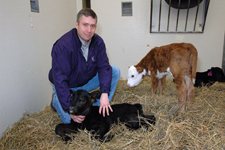Beef cattle and E. coli
Veterinary researchers test promising vaccine
Despite millions of dollars spent on food safety research over the last 10 years, ground beef recalls due to E. coli O157:H7 were higher in 2007 than in 2006. Dan Thomson, an associate professor of clinical sciences, is working to change that.
 "We have been studying the effects of a novel vaccine technology to make beef safer," said Thomson.
"We have been studying the effects of a novel vaccine technology to make beef safer," said Thomson.
He's working with Guy Loneragan of West Texas A&M and T.G. Nagaraja of K-State to examine the vaccine's ability to decrease E. coli shedding in beef cattle.
"We had a decrease in cattle shedding E. coli by 54 percent in our first field study," Thomson said. "However, we increased the amount of SRP exposure in the second field study and decreased the rate of shedding by 85 percent."
SRP is "siderophore receptor and porin" technology, which was developed by Epitopix LLC in Willmar, Minn.
Reducing the burden of E. coli O157 on cattle entering packing plants would represent "tremendous progress toward preventing E. coli O157 from ever getting into ground beef," Loneragan said.
The team's findings were presented at the 2008 Beef Industry Safety Summit in Dallas March 5.
Food-borne pathogens use siderophore receptor and porin proteins to acquire iron. "Iron is to bacteria as oxygen is to humans," Thomson said. "Without iron consumption, the bacteria suffocate and can't grow or replicate."
The SRP vaccine keeps the bacteria from taking up iron.
"We conducted a challenge study, a natural infection study and two large pen field studies at commercial feedyards," Thomson said.
"All studies showed positive results of this vaccine, making an impact on decreasing not only the number of the cattle shedding the bacteria but also decreasing the concentration of the bacteria being shed."
The number of "super shedder" cattle also was reduced.
The two large pen studies used 20 pens and more than 1,200 head of cattle.
The first study, conducted in 2006, was funded in part by beef and veal producers and importers through their $1-per-head checkoff and was produced for the Cattlemen's Beef Board and state beef councils by the National Cattlemen's Beef Association. Epitopix sponsored the second study in 2007.
Photo: Dan Thomson has worked with a vaccine that prevents a virulent strain of E. coli from reproducing by blocking its ability to absorb iron. Photo by David Adams, College of Veterinary Medicine.